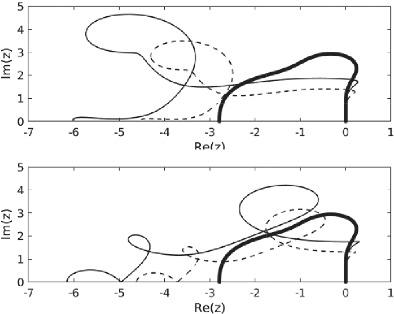当前位置:
X-MOL 学术
›
Int. J. Numer. Methods Fluids
›
论文详情
Our official English website, www.x-mol.net, welcomes your
feedback! (Note: you will need to create a separate account there.)
Explicit two‐step Runge‐Kutta methods for computational fluid dynamics solvers
International Journal for Numerical Methods in Fluids ( IF 1.7 ) Pub Date : 2020-07-12 , DOI: 10.1002/fld.4890 Alejandro Figueroa 1 , Zdzisław Jackiewicz 2, 3 , Rainald Löhner 1
International Journal for Numerical Methods in Fluids ( IF 1.7 ) Pub Date : 2020-07-12 , DOI: 10.1002/fld.4890 Alejandro Figueroa 1 , Zdzisław Jackiewicz 2, 3 , Rainald Löhner 1
Affiliation

|
Computational fluid dynamics (CFD) has emerged as a successful tool for industry applications and basic science during the last decades. However, accurate solutions involving vortex propagation, and separated and turbulent flows, are still associated with high computing costs. In particular, large eddy simulations (LES) of complex geometries, such as a complete automobile, require several days on thousands of cores in order to obtain solutions with statistically relevant information. With an increase in the number of available cores, the number of degrees of freedom (DOF) per core can be reduced accordingly. When the number of DOF per core is below a certain threshold the total simulation time is not bounded by floating point operations (FLOPS), but by the time spend on communication between cores. To overcome this impediment we have identified and tested a class of two‐step Runge‐Kutta (TSRK) methods of high order with low number of stages, for time discretization of differential systems resulting from space discretization of weakly compressible Navier‐Stokes equations. These methods have not been used before in CFD simulations. The advantage of using these methods is reduction in communication times between cores. The numerical experiments indicate that the gains in computational performance of this new class of TSRK methods, as compared with classical Runge‐Kutta (RK) methods or low storage Runge‐Kutta (LSRK) schemes, are of the order of 25%, with no loss in accuracy.
中文翻译:

计算流体力学求解器的显式两步Runge-Kutta方法
在过去的几十年中,计算流体动力学(CFD)已经成为工业应用和基础科学的成功工具。但是,涉及涡旋传播以及分离和湍流的精确解决方案仍然与高计算成本相关联。尤其是,复杂几何体(例如整辆汽车)的大涡模拟(LES)需要在数以千计的岩心上进行数天,才能获得具有统计相关信息的解决方案。随着可用核数的增加,每个核的自由度(DOF)数可相应减少。当每个内核的DOF数量低于某个阈值时,总的仿真时间不受浮点运算(FLOPS)的限制,而是受内核之间通信所花费的时间限制。为了克服这一障碍,我们已经确定并测试了一类两阶段的高阶Runge-Kutta(TSRK)方法,该方法具有低阶数,用于微分可压缩Navier-Stokes方程的空间离散化导致的微分系统的时间离散化。这些方法之前从未在CFD模拟中使用。使用这些方法的优点是减少了内核之间的通信时间。数值实验表明,与经典的Runge-Kutta(RK)方法或低存储Runge-Kutta(LSRK)方案相比,这种新型TSRK方法在计算性能上的收益约为 用于微分可压缩Navier-Stokes方程的空间离散化导致的微分系统的时间离散化。这些方法之前从未在CFD模拟中使用。使用这些方法的优点是减少了内核之间的通信时间。数值实验表明,与经典的Runge-Kutta(RK)方法或低存储Runge-Kutta(LSRK)方案相比,这种新型TSRK方法在计算性能上的收益约为 用于微分可压缩Navier-Stokes方程的空间离散化导致的微分系统的时间离散化。这些方法之前从未在CFD模拟中使用。使用这些方法的优点是减少了内核之间的通信时间。数值实验表明,与经典的Runge-Kutta(RK)方法或低存储Runge-Kutta(LSRK)方案相比,这种新型TSRK方法在计算性能上的收益约为25 %,而不会损失准确性。
更新日期:2020-07-12
中文翻译:

计算流体力学求解器的显式两步Runge-Kutta方法
在过去的几十年中,计算流体动力学(CFD)已经成为工业应用和基础科学的成功工具。但是,涉及涡旋传播以及分离和湍流的精确解决方案仍然与高计算成本相关联。尤其是,复杂几何体(例如整辆汽车)的大涡模拟(LES)需要在数以千计的岩心上进行数天,才能获得具有统计相关信息的解决方案。随着可用核数的增加,每个核的自由度(DOF)数可相应减少。当每个内核的DOF数量低于某个阈值时,总的仿真时间不受浮点运算(FLOPS)的限制,而是受内核之间通信所花费的时间限制。为了克服这一障碍,我们已经确定并测试了一类两阶段的高阶Runge-Kutta(TSRK)方法,该方法具有低阶数,用于微分可压缩Navier-Stokes方程的空间离散化导致的微分系统的时间离散化。这些方法之前从未在CFD模拟中使用。使用这些方法的优点是减少了内核之间的通信时间。数值实验表明,与经典的Runge-Kutta(RK)方法或低存储Runge-Kutta(LSRK)方案相比,这种新型TSRK方法在计算性能上的收益约为 用于微分可压缩Navier-Stokes方程的空间离散化导致的微分系统的时间离散化。这些方法之前从未在CFD模拟中使用。使用这些方法的优点是减少了内核之间的通信时间。数值实验表明,与经典的Runge-Kutta(RK)方法或低存储Runge-Kutta(LSRK)方案相比,这种新型TSRK方法在计算性能上的收益约为 用于微分可压缩Navier-Stokes方程的空间离散化导致的微分系统的时间离散化。这些方法之前从未在CFD模拟中使用。使用这些方法的优点是减少了内核之间的通信时间。数值实验表明,与经典的Runge-Kutta(RK)方法或低存储Runge-Kutta(LSRK)方案相比,这种新型TSRK方法在计算性能上的收益约为25 %,而不会损失准确性。









































 京公网安备 11010802027423号
京公网安备 11010802027423号